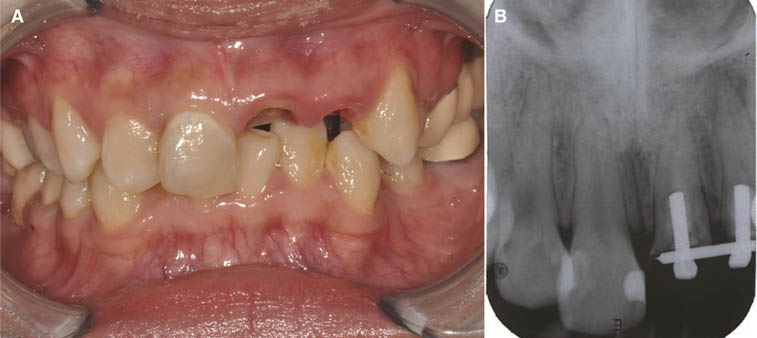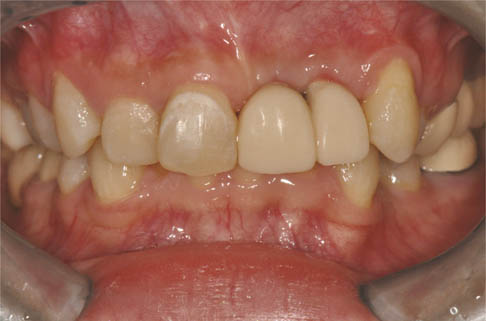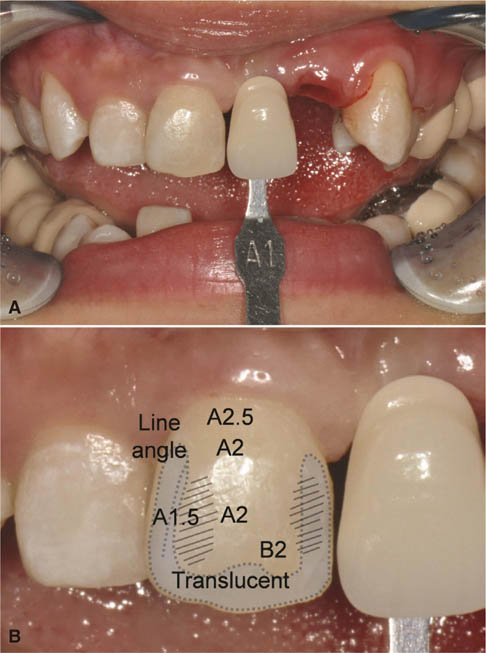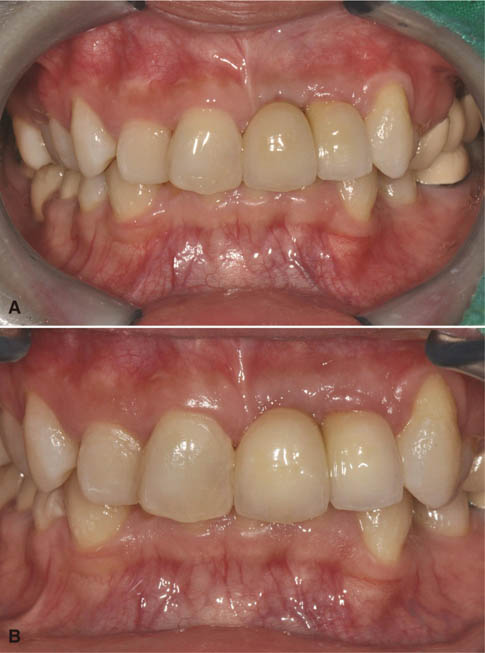J Adv Prosthodont.
2013 Aug;5(3):359-363. 10.4047/jap.2013.5.3.359.
Minimally invasive treatment for esthetic enhancement of white spot lesion in adjacent tooth
- Affiliations
-
- 1Department of Dentistry, Uijeongbu St. Mary's Hospital, Catholic University of Korea, Uijeongbu, Republic of Korea.
- 2Department of Prosthodontics and Research Institute of Oral Science, Gangneung-Wonju National University, Gangneung, Republic of Korea. lila@gwnu.ac.kr
- KMID: 2118177
- DOI: http://doi.org/10.4047/jap.2013.5.3.359
Abstract
- This article describes the treatment provided to a patient with the maxillary anterior teeth exhibiting severe secondary caries beneath the previous restoration and a white spot lesion on the adjacent incisor. Two implants were placed after extraction of hopeless teeth with the guided bone regeneration technique. A white spot lesion of the adjacent incisor was treated with minimally invasive treatment. This clinical report describes the multidisciplinary treatment for the white spot lesion and esthetic restoration of missing anterior teeth.
Keyword
Figure
Reference
-
1. Paris S, Meyer-Lueckel H. Masking of labial enamel white spot lesions by resin infiltration-a clinical report. Quintessence Int. 2009; 40:713–718.2. Loesche WJ. Chemotherapy of dental plaque infections. Oral Sci Rev. 1976; 9:65–107.3. Kidd EA, Fejerskov O. What constitutes dental caries? Histopathology of carious enamel and dentin related to the action of cariogenic biofilms. J Dent Res. 2004; 83:C35–C38.4. Suzuki M, Jordan RE, Skinner DH, Boksman L. Clinical management of non-carious enamel defects. Int Dent J. 1982; 32:148–158.5. Ellwood RP, O'Mullane D. Enamel opacities and dental esthetics. J Public Health Dent. 1995; 55:171–176.6. Ardu S, Castioni NV, Benbachir N, Krejci I. Minimally invasive treatment of white spot enamel lesions. Quintessence Int. 2007; 38:633–636.7. Rocha Gomes Torres C, Borges AB, Torres LM, Gomes IS, de Oliveira RS. Effect of caries infiltration technique and fluoride therapy on the colour masking of white spot lesions. J Dent. 2011; 39:202–207.8. Kim S, Kim EY, Jeong TS, Kim JW. The evaluation of resin infiltration for masking labial enamel white spot lesions. Int J Paediatr Dent. 2011; 21:241–248.9. Bussadori SK, do Rego MA, da Silva PE, Pinto MM, Pinto AC. Esthetic alternative for fluorosis blemishes with the usage of a dual bleaching system based on hydrogen peroxide at 35%. J Clin Pediatr Dent. 2004; 28:143–146.10. Greenwall L. Bleaching techniques in restorative dentistry: An illustrated guide. London: Martin Dunitz;2001.11. Goldstein RE. Esthetics in dentistry. 2nd ed. Hamilton: B.C. Decker;2001.12. Glockner K, Ebeleseder K, Städtler P. The bleaching of stained anterior teeth. Schweiz Monatsschr Zahnmed. 1997; 107:413–425.13. Basting RT, Rodrigues Júnior AL, Serra MC. The effect of 10% carbamide peroxide bleaching material on microhardness of sound and demineralized enamel and dentin in situ. Oper Dent. 2001; 26:531–539.14. Malterud MI. Minimally invasive restorative dentistry: a biomimetic approach. Pract Proced Aesthet Dent. 2006; 18:409–414.15. Stahl J, Zandona AF. Rationale and protocol for the treatment of non-cavitated smooth surface carious lesions. Gen Dent. 2007; 55:105–111.16. White JM, Eakle WS. Rationale and treatment approach in minimally invasive dentistry. J Am Dent Assoc. 2000; 131:13S–19S.17. Christensen GJ. The advantages of minimally invasive dentistry. J Am Dent Assoc. 2005; 136:1563–1565.18. Paris S, Meyer-Lueckel H, Cölfen H, Kielbassa AM. Resin infiltration of artificial enamel caries lesions with experimental light curing resins. Dent Mater J. 2007; 26:582–588.19. Paris S, Meyer-Lueckel H, Kielbassa AM. Resin infiltration of natural caries lesions. J Dent Res. 2007; 86:662–666.20. Meyer-Lueckel H, Paris S. Improved resin infiltration of natural caries lesions. J Dent Res. 2008; 87:1112–1116.
- Full Text Links
- Actions
-
Cited
- CITED
-
- Close
- Share
- Similar articles
-
- Non-destructive management of white spot lesions by using tooth jewelry
- Clinical performance of esthetic ceramic partial-coverage restorations with supra-gingival margin using minimally invasive tooth preparation method according to the concept of adhesive dentistry
- Outcome Evaluation of an Immediately Placed Maxillary Anterior Single-Tooth Implant Using Objective Esthetic Criteria: Case Report
- A New Beginning for the Journal of Minimally Invasive Surgery for the International Recognition and Contribution of Scientific Development of Minimally Invasive Surgery
- An esthetic appliance for the management of crown-root fracture: a case report







